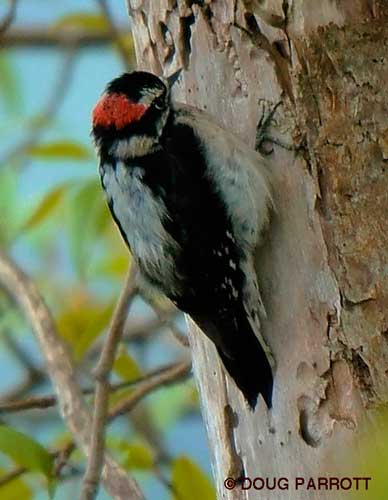It must be hard to be a woodpecker. For one thing, all that head-banging can’t be good for your brains. More to the point, how does one even go about finding the right piece of wood to bang your head against? The number of trees and snags in the Fill is large. They can’t all have insects under their bark.
Luckily this past week, the Downy Woodpecker family that has been nesting in the cottonwoods at Boy Scout Pond all spring put on a demo on just this topic. I was privileged to be in the audience. Here’s how it’s done.
First, mom came roller-coasting out of the woods and landed in a dead snag bordering the marsh. She began banging away at the wood. Soon junior came bouncing out to join her, followed by dad, whose little red topknot gleamed in the weak sunlight. Junior watched intently as mom pecked vigorously on the trunk of the snag. Her bill moved so fast it was impossible to see the motion distinctly – only a blur showed in my binoculars. She stopped a few times, as if encouraging her little one to try. But junior was clueless. So dad tried his beak at the lesson. He flew to another tree and waited till the family positioned themselves on the tree. Then, WHANG WHANG WHANG.
It is said that woodpeckers can detect their larval prey through sound. I find this hard to believe, given the noisiness of the Fill – the constant whooshing of traffic across the bridge, the drone of the Laurelhurst neighbor’s pontoon plane taking off, the shouts of the crew coaches spurring their kids on to greater effort. There is always a lot of noise pollution in the city. How can you hope to hear a sound as tiny as that of a grub inching its way inside the wood of a tree?
But my husband, the physicist, has no trouble believing this tale. “When I was a paperboy in Iowa,” he said, “I could always sense when one of my customers was hiding in the closet so he wouldn’t have to pay me when I came around to collect for delivering his newspapers. I would knock against the door and listen for a body taking up space in the room, just like a carpenter knocks against a wall and listens for a stud. If that didn’t work, I would knock again and freeze. Somehow, I always knew when my customer was there, standing just behind the door, trying to breathe without a sound. I think I could sense my prey’s vibrations through my feet. A paperboy with sensitive feet can go far in this world.”
I still don’t know if I believe that woodpeckers can hear grubs moving inside wood. But I am willing to concede that beings different from me can have senses I cannot hope to understand.
